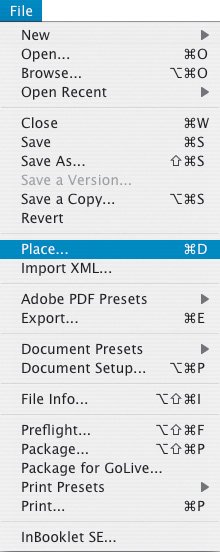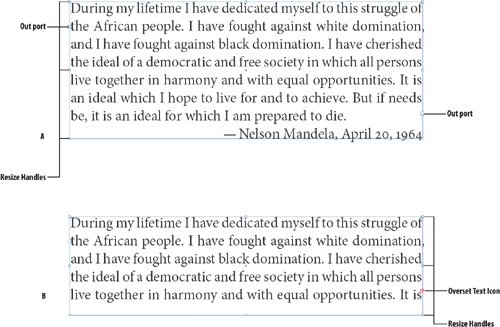Text Flow
Before using any of the text-flow methods, first "load" your cursor. To do that choose File>Place, navigate to the text file you wish to import, and then click Open.
For those of you who remember PageMaker, InDesign's text-flow methods will feel comfortably familiar. Those more familiar with QuarkXPress may be tempted to say something like, "You mean I don't have to draw a text box?"because InDesign's text-flow methods are fast and fluid.
Once you have a loaded type cursor, the size of your text frame is determined by the document's column and margin settings. Simply click at the top of the column to flow a single column of text. Note that the arrow in the loaded cursor icon will change from black to white when the cursor is over a guide. If there's more text to comeoverset textyou'll need to click on the red arrow at the bottom left of the text frame to "reload" your cursor. Then move to where you want the over matter to goeither a new column or a new pageand click at the top of the column or page to flow another text frame.
Figure 2.2. The Place Menu (Cmd+D/Ctrl+D).

Alternatively, if you don't want the width and depth of a text frame determined by your document's columns, click and drag the loaded type cursor to the size you want. When you release the mouse button, text will flow into the area you have defined. If there is more text to be placed, click the out port to reload your cursor, then click in the next text frame to continue the text flow.
Each text frame contains an in port and an out port, which are used to make connections to other text frames. An empty in port or out port indicates the beginning or end of a story, respectively. An arrow in a port indicates that the frame is linked to another frame. A red plus sign (+) in an out port indicates that there is overset textmore text than will fit in the current text frame(s). To flow the overset text, select the frame with the Selection Tool, click the out port, and then flow another text frame.
Figure 2.3. Anatomy of a Text Frame. A. Text frame containing a whole story. B. The same text frame resized so that the text is overset.

Figure 2.4. Manual Text Flow icon.

Figure 2.5. The Autoflow icon.

Figure 2.6. The Semi-Autoflow icon.

Figure 2.7. Fixed Page Autoflow icon .

Part I: Character Formats
Getting Started
- Getting Started
- An InDesign Type Map: Where to Find Stuff
- Viewing Your Page
- Creating a Typography Workspace
- Up Next
Going with the Flow
- Going with the Flow
- A Blank Sheet: Typing on Your Page
- Text Flow
- Threading Text Frames
- Using Placeholder Text
- Pasting Text
- Importing Word Text
- Up Next
Character Reference
- Character Reference
- Less is More, Maybe
- Type Anatomy
- Type Classification
- Character Formatting Options
- Readability
- Up Next
Getting the Lead Out
- Getting the Lead Out
- How Much Is Enough?
- (Not) Using Auto Leading
- Keep It Consistent, Except. . .
- Leading Menu Options and Keyboard Shortcuts
- See Also
- Up Next
Kern, Baby, Kern
- Kern, Baby, Kern
- When to Kern
- Metrics Kerning
- Optical Kerning
- Manual Kerning
- How Much to Kern
- Tracking
- When to Track
- Controlling Widows and Orphans
- Up Next
Sweating the Small Stuff: Special Characters, White Space, and Glyphs
- Sweating the Small Stuff: Special Characters, White Space, and Glyphs
- Typographers Quotes
- Apostrophes
- Dashes
- Ellipses
- End Marks
- White Space Characters
- The Glyphs Palette
- Footnotes
- Footnote Options
- Up Next
OpenType: The New Frontier in Font Technology
- OpenType: The New Frontier in Font Technology
- Ligatures
- Discretionary Ligatures
- Ordinals/Raised and Lowered Characters
- Swash Characters
- Fractions
- Oldstyle Figures
- Contextual Alternates
- Opticals
- Glyph Positioning
- Stylistic Sets
- Up Next
Part II: Paragraph Formats
Aligning Your Type
- Aligning Your Type
- Centering Type
- Clean Shaven or Rugged: Justified vs. Ragged Type
- How InDesign Justifies Type
- Balancing Ragged Lines
- Right-Aligned Type
- Optical Margin Alignment
- Indent to Here
- Vertical Alignment
- Up Next
Paragraph Indents and Spacing
First Impressions: Creating Great Opening Paragraphs
- First Impressions: Creating Great Opening Paragraphs
- Creating a Simple Drop Cap
- Drop Cap Aesthetics
- Tricks with Drop Caps
- Up Next
Dont Fear the Hyphen
Mastering Tabs and Tables
- Mastering Tabs and Tables
- Setting Tabs
- Creating Decimal Tabs
- Using Tab Leaders
- Reply Forms
- Numbered Lists
- Right Indent Tab
- Working with Tables
- Creating a Table
- Working with Rows and Columns
- Working with Table Cells
- Up Next
Part III: Styles
Stylin with Paragraph and Character Styles
- Stylin with Paragraph and Character Styles
- Creating Styles
- Applying Styles
- Editing Styles
- Redefining Styles
- Creating Default Styles
- A Typical Style Sheet
- Up Next
Mo Style
Part IV: Page Layout
Setting Up Your Document
- Setting Up Your Document
- Choosing a Page Size
- Determining Margins
- Determining Column Width
- Changing Columns
- Break Characters
- Page Numbers
- Section Markers
- Up Next
Everything in Its Right Place: Using Grids
- Everything in Its Right Place: Using Grids
- Things to Consider
- Your Grid Tool Kit
- Calculating the Height of the Type Area
- Align to Grid
- First Baseline Options
- Snap to Guides
- Up Next
Text Wraps: The Good, the Bad, and the Ugly
- Text Wraps: The Good, the Bad, and the Ugly
- Applying Text Wraps
- Wrapping Type Around Irregularly Shaped Graphics
- Text Wrap Preferences
- Ignoring Text Wrap
- Anchored Objects
- Up Next
Type Effects
EAN: 2147483647
Pages: 186
